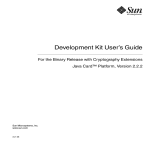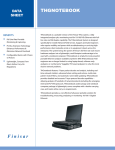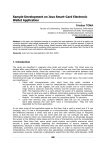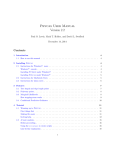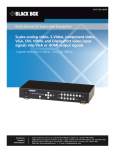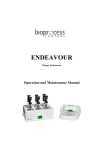Download Target Testing with the SAS PacketMaker II
Transcript
SAS PacketMaker™ II Serial Attached SCSI (SAS) Traffic Generator/Exerciser/Tester Application Note Target Testing with the SAS PacketMaker II OVERVIEW The Packet Maker II (PM2) is a flexible traffic generator for Serial Attached SCSI and Serial ATA. It provides full link control of bus traffic and an immense array of features, allowing users to test a variety of SAS specifications. This application note provides information on how to use the PM2 as a target tester using the user interface. HARDWARE SETUP Using the PM2 and Bus Doctor SAS analyzer together is the best configuration for analyzing SAS devices. Figure 1 shows a typical SAS testing set up. The PM2 can be used to script a variety of traffic scenarios, while the analyzer can be used to see detailed responses from the device under test. LINK RESET SEQUENCE After the connecting the hardware, the PM2 and target under test must be taken through a Link Reset Sequence (see Figure 2). Only once the Link Reset sequence is completed can the device be ready to accept connections, receive commands, and send responses. The simplest way to start a SAS target is to put the PM2 in Link mode (see page 3-3 of the PacketMaker II Users Manual). In Link mode each SAS frame will be scripted out individually. Figure 1: PM2 and Bus Doctor Configuration In order to start a SAS target it is necessary to first complete the phy reset sequence through Out of Band signaling. A typical OOB sequence would look like the following. Initiator to Target: Target to Initiator: Initiator to Target: Target to Initiator: COMRESET COMINIT COMSAS COMSAS This sequence is accomplished in the PM2 by laying down a COMRESET/COMINIT/COMSAS packet. PM2 currently operates at a top line rate of 3.0 Gb/s so a SAS speed negotiation sequence take place. (i.e. 1.5 or 3.0 Gb/s) After the phy reset sequence, a SAS initiator and target will go through an Identification sequence. This sequence begins with the target sending the initiator an IDENTIFY frame. If the PM2 is used as an initiator emulator, the packet stream should have a Wait For IDENTIFY packet directly after the COMRESET/COMINIT/SAS packet (see Figure 3). A Wait For IDENTIFY will cause the PM2 to pause in the packet stream and wait for a IDENTIFY frame from the target. Once it receives the IDENTIFY frame the PM2 should respond with another IDENTIFY frame. In order for the target to recognize the PM2 as a SAS initiator it is important to set the "SSP Initiator" field to TRUE with the IDENTIFY frame (see Figures 4 and 5). COMMANDS Once the Link Reset sequence is Figure 3: completed, the PM2 and target are ready to send and receive commands. The simplest way to accomplish this is to set the PM2 to Port Mode. When the PM2 is in Port Mode, all connection negotiations will be automated. The PM2 will also automatically respond to DONE and CLOSE primitives received from the target. Port Mode uses Command Sequences rather than packets. Each Command Sequence represents a packet stream. To send a command, start by placing a Command Sequence (See Figures 6 & 7). Figure 2: Link Reset Sequence 2 Next assign it to a packet stream by double clicking on it. For many types of commands, the sub-packet stream should only have a command frame in it with the appropriate command specified in the SCSI command field (see Figure 8). ADDRESSING Before sending a packet stream in either Link Mode or Port Mode it is sequence with each SAS device connected to each port. After the Identification sequence the destination address of each device will be noted in the Dest Addr (0x) field. Pressing the "Insert Addr Info" button will set the addresses in the active packet stream to the addresses specified in the Src Addr and Dest Addr fields. This will also include Hashed the Port Links matrix. ADDRESSING IN PORT MODE When the PM2 is set in Port Mode, the "Insert Addr Info" button will not appear. This is because the addressing is automatic in Port Mode. Connections will be addressed according to what is set in the Port Src Addr and Dest Addr fields. Figure 4: Wait For IDENTIFY Sequence Figure 5: Set SSP Initiator Field to True important to make sure the packet stream is addressed correctly. Each SAS device has a global address and the PM2 must direct each packet in the packet stream to the correct address. Each Outside Connection frame, SSP frame, and SMP frame has address fields that must be set correctly. The easiest way to accomplish this is in the Configuration options under the Port Settings tab (See pg. 5-13 of the PM2 user manual). ADDRESSING IN LINK MODE In Link Mode each frame is addressed according to its source and destination address fields. These fields could be set manually, but a faster method is to us the Port Settings parameters noted above. The "Get Dest Addrs" button will automatically go through the phy reset Address Fields. The Device Type field must also be set correctly so that the PM2 will be able to put the addresses in the correct location. Figure 6: Placing a Command Sequence Figure 7: Start/Stop Command Sequence In order for the "Get Dest Addrs" and "Insert Addr Info" buttons to work correctly the port must first be mapped to a specific link. This can be done in This will apply to the OPEN frames, which are sent automatically, as well as SSP and SMP frames, which are scripted by the user. The "Get Dest Addrs" button will automatically go through the phy reset sequence with each SAS device connected to each port. After the Identification sequence the destination address of each device will be noted in the Dest Addr (0x) field. In order for the "Get Dest Addrs" button to work correctly the port must first be mapped to a specific link. This can be done in the Port Links matrix (see Figure 9). PORT LINKS MATRIX The Port Links Matrix maps specific ports to individual links. One PM2 can have up to four links, and two PM2 cards can be linked together ... continued on next graphics Figure 8: Start/Stop Command Sequence 3 for a total of eight possible links and ports. A number of different links can be mapped to each port to emulate wide port conditions. If the PM2 is in Port Mode and Link 1 is mapped to Port 1 (as it is in Figure 10) then any packet stream scripted to Port 1 will go to Link 1 on the PM2. In this scenario, pressing the "Get Dest Addrs" button in the Port Settings menu will set the target address of the device on Link 1 to the Dest Addr field of Port 1. CONCLUSION This application note provides detailed information on how to use the PM2 as a target tester. Figure 9: Port Links Matrix Figure 10: Port Settings PRODUCT ORDERING INFORMATION Model Number Description PacketMaker II Traffic Generators(1) PM-SAS-1501e PM-SAS-1504e PM-SAS-1504Qe SAS PacketMaker II, 1 Phy Link, (1.5 Gb/s)(2) SAS PacketMaker II, 4 Phy Link, (1.5 Gb/s)(2) SAS PacketMaker II, 4 Phy Link, H/W emulation, (1.5 Gb/s)(2) PM-SAS-3001e PM-SAS-3002e SAS PacketMaker II, 1 Phy Link, (1.5 & 3.0 Gb/s)(2) SAS PacketMaker II, 4 Phy Link, (1.5 & 3.0 Gb/s)(2) PM-DEV PM-SVT PacketMaker Development Software Upgrade(3)(4) PacketMaker II SAS Validation Tool(4) Software Model Number RX-108P-SLIM RX-108P-FIT RX-108P-BUFF Description (SAS Analyzers/Related Products) USB-Controlled Analyzers Bus Doctor RX, 108 channels, 64M events buffer Bus Doctor RX, 108 channels, 128M events buffer Bus Doctor RX, 108 channels, 256M events buffer RX-252P-SLIM RX-252P-FIT RX-252P-BUFF Bus Doctor RX, 252 channels, 64M events buffer Bus Doctor RX, 252 channels, 128M events buffer Bus Doctor RX, 252 channels, 256M events buffer DR-SAS-3000 DR-SATA-3000 Serial Attached SCSI pod, (1.5 & 3.0 Gb/s)(5) Serial ATA pod, (1.5 & 3.0 Gb/s)(5) DR-SAS-3004 DR-SAS-30W4 SAS Pod, 4 Phy Link, (1.5 & 3.0 Gb/s), SATA Connectors(6) SAS Pod, 4 Phy Link, (1.5 & 3.0 Gb/s), MicroGIGA Connectors(6) Bus Pods (1): Includes: PM2 board, GUI control software, user manual and API. (2): Includes PM-DEV. (3): Provides 3 SAS/SATA focused PacketMaker II test tools that will dramatically cut the development process and time-to-market of new SAS/SATA devices. a) Extreme SCSI issues any SCSI command to any device running the SAS/SATA protocols. b) Extreme Manufacturing test environment is designed for SAS/SATA peripheral testing as well as manufacturing, DVT, ORT, incoming inspection and final inspection. c) Scriptgen is an easy to use tool for rapidly creating simple or complex test scripts. (4): Requires a PacketMaker II Traffic Generator. (5): Compatible with RX-108P Analyzers. (6): Compatible with RX-252P Analyzers. 1389 Moffett Park Drive • Sunnyvale, CA 94089 Phone (US Toll Free): 888.746.6484 Phone Intl: 408.400.1000 Email: [email protected] www.finisar.com PMS 2745






